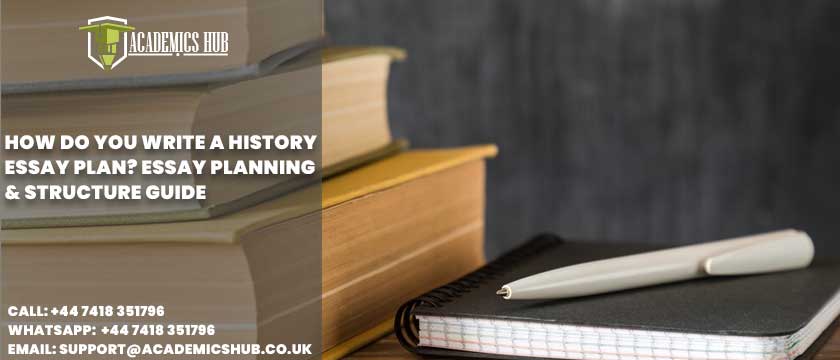Are you worried about how to write a history essay plan? Writing an academic essay entails putting together a logical argument from a collection of thoughts. Because essays are primarily linear (they provide one thought at a time), they must express their ideas in the most logical order for the reader. A successful essay structure requires the writer to dictate the information readers need to know. The purpose of the essay is to give a coherent, well-thought-out argument in response to a specific question. An effective essay structure aids the reader’s understanding of your argument. During academic life, students undertake this subject, but when it comes to essay writing. They stuck and find it quite challenging to craft a perfect history essay plan.
Every student desire to achieve high grades during their academic career. But due to many reasons’ students can’t produce high-quality history assignments. Students wonder and ask: how to write a history essay plan? Can someone do my history homework? Indeed, you can. Many academic writing services offer assignment assistance to students struggling with academic problems. To make it easy for the students, I have mentioned the structural guide about a history essay plan.
Making A History Essay Plan

It’s always a good idea to finish the first seven steps as soon as you get your essay question. That way, the knowledge will be fresh, and you will be more inclined to think about your essay plan while doing other things. Here are the first seven steps of essay planning.
- Concentrate on the essay question promptly.
- Spend at least a half-hour thinking about ideas for the topic.
- Make a list of your opinions about the topic, its scope, and different parts of the inquiry.
- List the terms or phrases that you believe should be included.
- List down the most important elements to include in your answer.
- Make a list of where you’ll get the information you need for each of the components in your thorough plan (lecture notes, course handouts, etc.). Make a note on the outline where you believe more study is required.
- Start putting together a more detailed plan by skimming through any course materials or lecture handouts. Scrutinize your lecture notes for anything pertinent to the assignment objective, and write down where you may locate it on your thorough plan.
If you’re not sure what to add at this point, talk to your instructor or a peer to make sure you’re on the right track.
Few More Steps Regarding History Essay Plan
Once you’ve completed the first seven steps and are confident that you know what you’re doing, expand on your initial ideas and create a more detailed essay outline.
- List other sources of information, such as books, journals, websites, and media sources, as needed.
- Be sure your outline doesn’t get too complicated; stick to the major elements and make sure it’s related to the inquiry.
- Also, check the necessary sections of a reading list or a core textbook if you’ve been provided one.
- After you’ve finished your history essay plan, think about the proportions: how many words you’ll need in total and how many words you’ll need for each component of your essay.
- Academic essays frequently have a word limit, and staying under that limit is crucial. Many universities will penalize students if they do not write the required number of words. So, make sure you do it according to your university guidelines.
- Consider the essential points that must be mentioned in the essay. Make sure the main body of the essay gets the most words, rather than a side topic.
- Moreover, calculate how much room you have for each area of your outline. For instance, a third of a page for the introduction, half a page for point 1 with two sub-points, one and a half pages for point 2 with five sub-points, and so forth. Although you will not strictly adhere to such a spacing arrangement, it will help you keep things under control and determine how much detail to provide while maintaining the balance of the essay you originally planned.
The Process of History Essay Plan

Because everyone works differently, you’ll need to find a planning and writing method that works for you. It’s crucial, though, not to jump from research to writing too rapidly. It’s a good idea to think about how you’ll organize your ideas and what your essay’s main point will be. Here are a few questions that you should ask yourself before essay planning:
- What do I already know about the topic that is relevant to the question?
- Do I comprehend what my assignment question is?
- What have other scholars said about this subject, and do I agree or disagree with them?
- What is the major argument or point I want to make in this essay?
- Is there anything more I need to know?
- What evidence do I have to back up my main point or message? (In other words, why should my reader trust me?)
Steps of Essay Planning
Breakdown Your Homework Question: Break down the various components of your homework question. Determine what the task word implies (e.g., discuss, argue, describe) and what you need to write about precisely. Decide which components of the issue to focus your answer on if the question is wide and generic.
Mind map Everything: Everything you already know about the topic should be mapped out in your mind. Try to figure out what your first reaction is to the essay question. Make a list of research questions to help you focus your reading.
Research: Make sure you maintain track of where you got your information. Engage with what you’re reading by asking questions and presenting counter-arguments. Furthermore, note things that are relevant to your essay title. You do not have to include every detail concerning the subject.
Analyze the Key Points: Identify essential points from your research that will assist you in answering the issue. You may group these in a mind map or write them down on a large sheet of paper or in a typed document. After that, you must begin organizing the points. Which of these are related? Which of the following are counter-arguments? Begin to organize your thoughts. Based on the material you’ve acquired and analyzed, you should also decide what your essay’s overarching argument will be.
Summarize: Choose a logical order for your points now. You could write a summary of each point on a separate card or sticky note and physically move them around until the best flow is found. You’ll figure out your strategy, but the most important thing is to be conscious of how your argument develops. How will your paragraphs contribute to the development of your argument? Remember to guide your reader through the process, communicating with them at each stage.
Guide About Essay Structure
Here is the guide about the essay structure. You can follow these steps to craft a compelling history essay.
Understand the Questions

An essay is not the place to show off all of your knowledge on a certain topic. Rather! It’s an opportunity for you to demonstrate your ability to marshal facts and statistics in support of a logical and persuasive argument. Writing a solid history essay necessitates relevance, and for your argument to be relevant, it must precisely answer the question. In every essay question, there will be keywords: discuss, analyse, compare, contrast, identify, and so on. You should treat these terms as if they were road signs directing you in the right route. Once you’ve understood these keywords and have a better idea of what you’re being asked to achieve, writing your essay will seem a lot easier. Let’s look at some examples of these keywords and how to best respond to them.
Introduction
The introduction is where you set out your thesis argument. Your essay will struggle to achieve top marks if it lacks a strong opening. That is why in this section, you must offer your essential response to the topic, restricting it to the points that defend this thesis and refraining from going into detail. Make careful to mention each point from the body paragraph, but avoid going into too much detail.
Body Paragraph
In this section, you have to defend your point of view. The primary points you’re utilizing to defend your argument should be the focus of the opening few paragraphs (two or more depending on the length of the essay). Each of these points should have its own paragraph, with facts, examples, and explanations of how they relate to the main idea. In body text, you have to present your arguments through strong evidence.
Conclusion
You must not raise any new points in this section that have not been addressed in the body of your essay. You should be careful not to copy the introduction. Instead, you should (thoroughly) condense your body paragraphs in order to support your main point. As a result, this should be the shortest paragraph; there is nothing new to refer to.
Summary
In this blog, I have discussed in detail how to write a history essay plan. Are you struggling with how to write a history essay? If yes! Then, you need to follow this step-by-step guide about the history essay plan. Later, I have mentioned the essay planning process and essay structure that you can use to compose a compelling essay. Still, if you are not comfortable in essay writing and wondering who will do my history homework, hire a professional essay writer to get a quality assignment solution.
